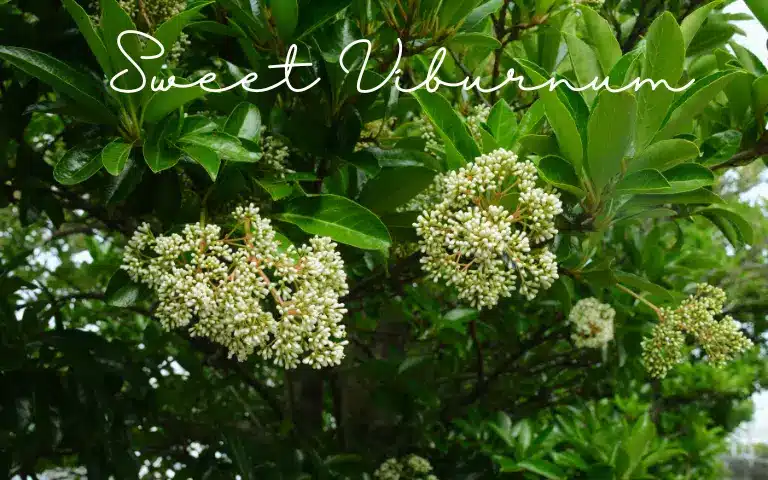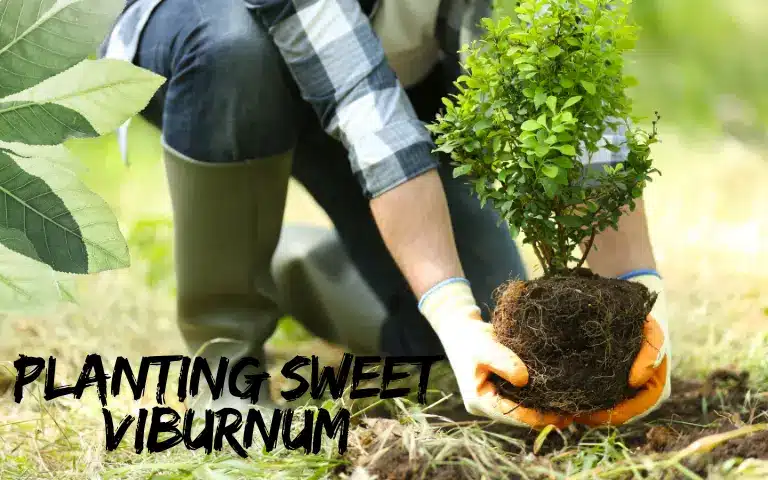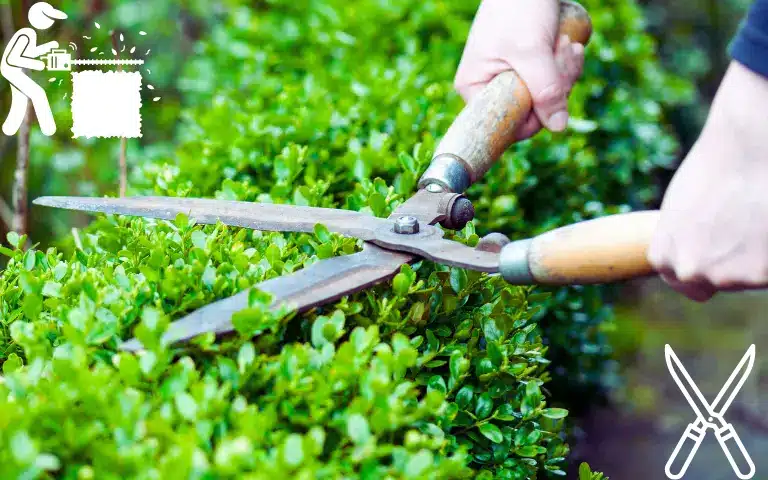If you’re looking for a hedge that will provide some privacy and create a more intimate feel, Sweet viburnum is the right tree to consider. It will be a nice addition.
What can I say about Viburnum tinus? Let’s see if I’ve got enough fingers. They are evergreen, bushy, and vigorous. They are long blooming and attract pollinators. You can plant them in partial shade or in full sun. They are deer-resistant and will tolerate exposed areas, high winds, and even coastal salts. I’ve run out of fingers, and even temperatures up to minus 10 degrees Celsius. It’s almost impossible to kill the thing.
- What is a Sweet Viburnum?
- What Does Sweet Viburnum Smell Like?
- Is Sweet Viburnum Deer Resistant?
- Why Should You Plant Sweet Viburnum?
- Planting Sweet Viburnum: Step-by-Step Guide
- How Fast Does Sweet Viburnum Grow?
- How Tall Does Sweet Viburnum Grow?
- Pruning Techniques for Sweet Viburnum
- How to Propagate Sweet Viburnum?
- Frequently Asked Questions
What is a Sweet Viburnum?

Sweet viburnum is a shrub or small tree native to China, Korea, Taiwan, Japan, the Himalayas and India, Myanmar, Thailand, Vietnam and the Philippines.
Characteristics
Sweet viburnum has large, glossy, dark-green leaves and small, fragrant white flowers in spring. The dull green leaves form a moderately coarse texture, and the flowers are often followed by small red berries that turn black.
Growing conditions
The sweet viburnum grows quickly in full sun or part shade on many types of soil. It is drought-resistant and can grow in non-irrigated landscapes. Once established, the sweet viburnum, grown as a tree, will require pruning to control its size and shape.
Companion plants
Good suggestions for companion plants include:
- Philodendron
- Hibiscus
- Buisson de feu nain
- Nandina domestica ‘Firepower’ ou ‘Super King’
- Ixora ‘Gold Mound’
- Oleander nain
- Vigne de patate douce
What Does Sweet Viburnum Smell Like?

You might be curious about the scent. It’s hard to describe, but picture this: a springtime scene. You’re suddenly surrounded by a sweet, citrusy smell. Think of a blend of honey, honeysuckle, and citrus. The smell is soft, alluring, and makes you smile.
Certain individuals describe it as reminiscent of freshly baked bread, whereas some liken it to a bunch of lilies. It is quite challenging not to be captivated by its aroma. I understand your doubts: “Can I rely on a stranger’s portrayal of a scent?” Your skepticism is valid! The most effective method to truly grasp the fragrance of sweet viburnum is to encounter it firsthand.
If you happen to have a local nursery close by, I strongly suggest dropping by to explore their viburnum assortment. These lovely flowers usually bloom in spring, allowing you to experience their enchanting fragrance firsthand. Believe me, it will be a delightful experience! In case you are fortunate to know someone who cultivates sweet viburnum, don’t hesitate to ask for a chance to smell them. You will be surprised by how much their aroma can positively impact your emotions.
Is Sweet Viburnum Deer Resistant?
You may be contemplating planting a delightful viburnum but have concerns about pesky deer feasting on it. I understand your worry. Those graceful grazers can indeed be quite a nuisance! The delightful news is that sweet viburnum is commonly considered resistant to deer.
Deer may not prioritize sweet viburnum on their menu, typically avoiding it. However, there are key considerations to bear in mind: Deer are selective eaters, but when desperate, they will consume almost anything.
To safeguard your sweet viburnum in a deer-heavy locale, extra measures should be taken:
- Young plants are at higher risk as deer tend to nibble on tender seedlings. Therefore, it’s crucial to shield your sweet viburnum until they mature.
- Plant within a fenced area for optimal protection against deer intrusion.
- Utilize deer repellents, trying out various options to discover the most effective one for your situation.
And if they do decide to nibble, at least they will enjoy a delightful, aromatic treat!
Why Should You Plant Sweet Viburnum?
Sometimes you need a plant that looks great in the fall and smells good. A sweet viburnum is sweet. It keeps on giving!
- The fall foliage is beautiful. The green leaves turn red, purple, and orange. Your neighbors will be jealous.
- Birds love the bright red berries that appear after the flowers fade.
- The flowers attract bees, butterflies, and other insects. Your viburnum will be buzzing with pollinators all season, keeping your garden healthy.
- It can grow in different types of soil. A sweet viburnum will thrive in any garden.
Planting Sweet Viburnum: Step-by-Step Guide

Choosing the right spot
You want your sweet viburnum to be happy and healthy, right? Let’s find the perfect place for it to thrive.
Sunlight:
The sweet viburnum plant thrives in partially shaded areas, particularly in regions with warmer temperatures. An environment with dappled shade is perfect for its growth. In colder climates, it can also withstand exposure to full sunlight.
How do you find out how much sun your garden gets? Just watch it throughout the day. Where does the sun shine the most? Where does it stay in the shade?
Soil:
Sweet viburnum can grow in most soil types, but it does best in well-drained soil. If your soil is heavy clay, add compost or other organic matter to improve drainage. What’s your soil like? Does it drain well? Or is it prone to getting soggy?
I’m not using starter fertilizer. I’m saving money and just letting the plants adapt to the soil as is. My soil is actually pretty good thanks to years of mulching.
Planting time
- Spring: When the ground is warm and there’s no more frost, it’s a good time to plant your sweet viburnum. It has time to grow.
- Fall: Plant your sweet viburnum before the ground freezes. It’ll have time to settle in before winter, and it’ll be ready to grow in the spring.
Preparing the planting hole
Excavate a cavity that is double the width of the root ball and equally deep, ensuring adequate space for the roots to expand. Enhance drainage and fertility by incorporating compost or other organic materials at the base of the hole, promoting the flourishing of your sweet viburnum plant.
Planting the viburnum
- Positioning: Put the plant in the hole, making sure the root ball is level with the soil. Make sure the top of the root ball is even with the soil.
- Backfilling: Fill the hole with soil. Gently pat down the soil around the plant to eliminate air pockets. The soil should be snug against the roots, but not too compact.
- Watering: Water your sweet viburnum thoroughly.
How Fast Does Sweet Viburnum Grow?
Are you eager to cultivate a lovely viburnum and curious about how long it will take to flourish completely? You must be looking forward to savoring the sweet-smelling blooms as soon as possible! The great news is that the sweet viburnum grows at a remarkable pace. While it won’t skyrocket like a weed, it will certainly show noticeable progress every year.
A young sweet viburnum can grow 1 to 2 feet a year. A 2-foot sapling will likely reach 4 to 6 feet in a few years.
Growth speed depends on a few things:
- Good soil makes the viburnum grow faster.
- Water your viburnum well, especially in the first few years.
- The sweet viburnum grows faster in full sun, especially in cooler climates.
How long will it take for your sweet viburnum to grow big? It takes about 3 to 5 years to reach full height. In a couple of years, you’ll see its beautiful blooms and enjoy its sweet fragrance. Isn’t it exciting? Plant your sweet viburnum! You’ll enjoy watching it grow.
How Tall Does Sweet Viburnum Grow?
It is essential to understand the potential size of a plant before planting it, don’t you agree? Sweet viburnum is not an overly large, sprawling creature. It maintains a fairly manageable size, though this can vary based on the specific variety you select.
Sweet viburnum types usually grow to 6 to 10 feet, making them suitable for small gardens, hedges, or screens. For a smaller option, try Carlesii or Burkwoodii, which usually reach 4 to 6 feet. For those looking for a taller variety, there’s the Juddii sweet viburnum, which can grow up to 15 feet tall! The height of your sweet viburnum depends on where you grow it. It may stay smaller in warmer climates. This plant will bring you many years of delight.
Pruning Techniques for Sweet Viburnum

Knowing the three pruning techniques – shape maintenance, height reduction, and rejuvenation – helps you create a thriving garden. With the right pruning, your Viburnum tinus will look great for years.
1. Maintaining shape
The first pruning technique is to keep the sweet viburnum tinus’s natural rounded shape.
- Trim any branches that are not part of the dense form.
- Cut deep into the shrub to avoid unsightly stubs.
This will encourage new growth to fill in the gaps, creating a well-shaped plant.
2. Height reduction
If your sweet viburnum flora has flourished beyond bounds, it’s time to give them a trim. Prune the stems to a preferred length of approximately 50 centimeters (18-20 inches) above the soil to manage the plant’s dimensions and forestall it from invading nearby spaces. This action allows additional sunlight and fresh air to reach the bush.
3. Rejuvenation
Should a sweet viburnum grow to be too wild and chaotic, consider rejuvenation pruning. Trim the entire plant down to a mere 50 centimeters (18-20 inches) above the soil level. The robust viburnum can bounce back with fresh energy if pruned after the final frost, thanks to its resilient nature.
How to Propagate Sweet Viburnum?
You have become enchanted by your charming viburnum, haven’t you? And now you wish to spread that enchantment to your companions and community. This is where propagation steps in! There are a couple of delightful methods you can employ:
Softwood cuttings
- In late spring or early summer, when the new growth is still soft and pliable, snip off 4- to 6-inch cuttings from the tips of the branches.
- Remove the leaves from the bottom inch or two of the cutting and make a diagonal cut at the bottom.
- Dip the cut ends in rooting hormone and stick them in a pot of moist potting mix.
- Cover the pot with a plastic dome to create a humid environment.
It can take several weeks for the cuttings to root. Keep them in a warm, sunny spot and make sure the soil stays moist.
Hardwood cuttings
This technique is most effective during autumn or winter when the branches are not actively growing. Let me walk you through the process:
- Take pieces of 6 to 8 inches from the new growth of the previous year.
- Strip the leaves from the lower part of the cutting and create a slanted cut at the base.
- You have the option to dip the cuttings in rooting hormone and plant them in a container with moist potting mix, or you can place them directly in the soil.
It may take a few months for hardwood cuttings to develop roots. Keep them in a cool, sheltered area and ensure the soil remains damp.
Which method should you choose?
Truly, both softwood and hardwood cuttings are effective for propagating sweet viburnum. Just opt for the approach that aligns with your timetable and the environment you are cultivating in. Moreover, if you’re up for some excitement, experiment with both techniques and determine your preference!
Planting and arranging the Sweet Viburnum has been a bit of a journey. However, I’m confident that the final result will be a beautiful, cohesive hedge that adds depth and interest to your garden.
Best used either as a loose hedge or in a mixed border. They’re great. They’re very dense, and they grow fast and tall, about six to eight feet tall and six feet wide, according to the books. The good news is it can be contained height-wise.
I can’t wait to see these plants thrive and contribute to the overall harmony of your outdoor space. Stay tuned for updates on the new hedge!
Frequently Asked Questions
When will my sweet viburnum bloom?
Well, you’ll usually see the flowers in late spring or early summer, depending on your climate.
Can I grow sweet viburnum in a pot?
You can grow sweet viburnum in a pot, but make sure the container is big enough for its roots. It needs more water than a plant in the ground.
Is sweet viburnum poisonous?
The berries are poisonous to humans, but don’t worry about the birds eating them.
Can I grow sweet viburnum from seed?
It’s easier to propagate sweet viburnum by taking cuttings.

About the Author
As a woman expert in sustainable, environmental, and natural farming methods.
I write about houseplant care sharing tips and tricks i’ve learned over the years to help keep your plants happy and healthy.



